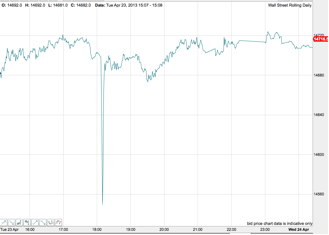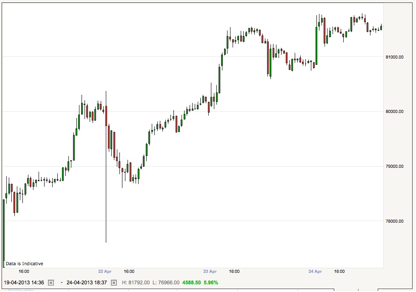 Wall St$90 billion in just 3 minutes.
Wall St$90 billion in just 3 minutes.
No, it isn’t the latest get-rich-quick scheme!
It’s how much was wiped of the US markets on Tuesday afternoon in the space of a few minutes.
These ‘flash crashes’ are happening more and more often, so today I’d like to show you how you can cash in the next time it happens…
So, what happened on Tuesday?
In a week when Human Rights Watch launched a new campaign against ‘killer robots’ (lethal armed robots that can target and kill without any human intervention) – it’s fitting that we also get a glimpse of how much power computers have over the global markets.
If you missed the now infamous tweet that caused the flash crash, this is what it looked like:

And this is the effect it had on the Dow Jones:

It turns out that the tweet was a result of the Associated Press’s Twitter account being hacked – and the markets quickly recognized that it was untrue and rebounded.
But what’s really interesting here is that this downward spike wasn’t caused by lots of eagle-eyed traders spotting the news story and quickly selling their shares.
It was because high-speed trading algorithms are now taking direct feeds from Twitter, and using them to affect their trading decisions.
Many of these financial firms are using middleman firms like RavenPack to filter Twitter feeds and ‘clean up’ messages for relevance. But it’s been suspected that some firms are just plugging Twitter feeds straight into their trading algorithms – and Tuesday’s flash crash goes to prove how much this is going on.
When the Twitter message hit, these high-speed firms immediately pulled out of the market, leaving a vacuum. Other high-speed firms quickly spotted the lack of liquidity, and followed suit.
And eight minutes later, the whole story was over, with price levels back to normal.
However, no doubt the result was thousands of traders having their stop levels hits, and incurring nasty levels of slippage in the process.
But surely, this kind of thing doesn’t happen very often…
It would be nice to think so, but here’s what happened to Google stocks on Monday this week:

See that big downward spike on Monday? Google shares fell more than 3% in less than a second.
The cause? No one knows.
These mini-flash-crashes are not uncommon.
First, I’ll look at some ways we can protect our trades against them, and then I’ll show you how you can set up a profit trap to catch rewards the next time one strikes.
The obvious way to protect ourselves from flash crashes is to not use stop losses
That way the market can bounce around all it likes without bumping us out of our trades.
However, if you’re not using stop levels, then you’ll have to have a system of hedged trades to protect your position with.
This means that if you’re buying EURUSD, you might balance this position with a trade on USDCHF. So, if the value of the euro goes down, you might lose out on your first trade. But, due to currency correlations, the value of the USD against the CHF is likely to go up, so the second trade will gain.
You can find out more about currency correlations here.
There are trading strategies out there that do this effectively. The big firms trade this way – using hedges to protect themselves rather than stop levels. It does require a level of confidence, however, to let the market wax and wane like this, and I know it simply doesn’t suit everyone.
So, how can we turn flash crashes to our advantage?
This little trick will allow you to use limit orders like little timebombs waiting to go off on the next flash crash.
Take a look at an instrument that you’d love to buy if only the price was lower. I’m talking about something that you wished you’d snapped up at a cheap price, but now it’s too late.
Now, place a limit buy order for that stock at your dream price.
Maybe your limit order will never be filled. It’ll just lie there in wait.
But if the next flash crash comes along… Bang! It’ll jump into action.
Sure, with the prices moving fast, you may not get filled at your level. But you’ve a good chance of grabbing yourself a bargain.
A word of warning – don’t do this on some high-risk stock, which may have suddenly fallen for good reason. Stick to bigger instruments.
And next time everyone’s moaning about flash crashes you’ll have a big smile on your face!
